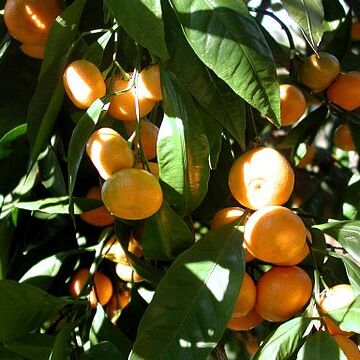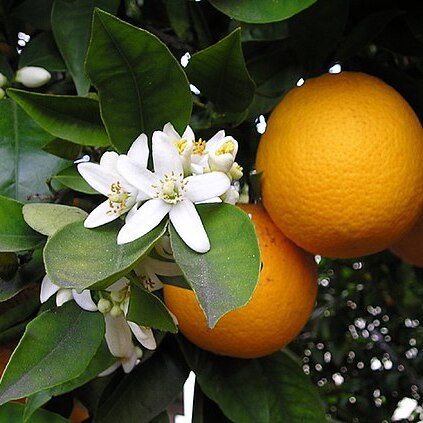Shrubs or small trees, evergreen, rarely deciduous. Young branches often flat and angled, usually with solitary (rarely paired) spines at axils. Leaves 1-foliolate, rarely 3-foliolate or simple; petiole usually articulated with base of leaf blade, usually conspicuously winged; leaf blade subleathery to leathery, with dense pellucid fragrant oil dots, margin crenulate or rarely entire. Flowers axillary, hermaphrodite or male, solitary or in small fascicles, fragrant. Calyx cup-shaped; lobes 3-5, subglabrous. Petals (3 or)4 or 5(-8), white or outside pinkish red, imbricate, thick. Stamens usually 4(-10) × as many as petals, free or basally coherent. Disk annular or short, with nectary glands. Ovary (3-)5-14(-18)-loculed, each locule with 2-8 or more ovules; stigma large. Fruit a berry (hesperidium) with sarcocarp segments of pulp vesicles and adaxially attached seeds. Seed coat smooth or ridged; embryo(s) 1 to many, like cotyledons milky white, green, or rarely yellowish, germination hypogeous.
Aromatic glabrous shrubs or small trees, usually armed with solitary axillary sharp brown-tipped green spines, the branchlets angled, soon terete, green, glandular punctate, the older branches often thornless. Leaves alternate, 1-folio-late, persistent; leaflets subcoriaceous, usually thin, glandular punctate through-out, entire to serrate, shiny dark green above, paler and duller beneath; petioles usually more or less winged and articulated with the leaflets. Flowers axillary, solitary, paired, or in short corymbose cymes, regular, (4-)5-merous, bisexual or staminate by more or less complete abortion of the gynoecium, 2-5 cm in diameter, often fragrant; plants dioecious or polygamous; calyx shallowly cupular, (4-)5-lobed, persistent, petals (4-)5(-8), free, white, pink, or purplish pink, slightly fleshy, more or less oblong, strongly glandular punctate, imbricate; stamens 20-60, usually 4(6-10) times as many as the petals, polyadelphous or
Evergreen, rarely deciduous, armed trees or shrubs. Young twigs angled or not, with solitary (rarely paired) spines in axils. Leaves unifoliolate, rarely 3-foliolate, imparipinnate (not in Australia) or apparently simple, sometimes dimorphic (seedlings with much smaller leaves), with dense pellucid oil glands, fragrant when crushed; petiole often pulvinate, often ± winged. Inflorescences small axillary fascicles or flowers solitary. Flowers bisexual or male (ovary aborted), fragrant. Calyx cupular, (3) 4-or 5-lobed. Petals (3) 4 or 5 (–8), imbricate. Stamens usually c. 4 times as many as petals but up to 10 times, free or basally coherent. Disc annular or short. Ovary (3–) 5–14 (–18)-locular, without gynophore, each locule with 2–8 or more ovules. Berry (hesperidium) with segments of pulp vesicles and adaxially attached seeds; pericarp with oil-glands. Seeds obovoid or flattened obovoid, ± angular with 1 or more embryos.
Evergreen shrubs or trees, usually thorny, especially on vegetative shoots. Lvs alternate, apparently simple, really reduced to 1 leaflet, very aromatic; petiole often articulated at apex, often winged; lamina dotted with glands. Fls axillary, solitary or clustered in cymes or panicles, usually ☿, usually (4)-5-merous, occasionally with petals more numerous. Calyx cup-shaped; lobes minute to prominent. Petals white, sometimes flushed pink on reverse. Stamens 15-many (to 10× as many as petals), arranged in bundles. Ovary (8)-10-14-(15)-celled. Ovules in 2 rows each of 4-8 per cell. Styles deciduous. Fr. a fleshy berry (hesperidium), usually large, ± globose, green, yellow, or orange; cells with pulpy vesicles surrounding the large polyembryonic seeds. Embryo green or white.
Small evergreen shrubs or trees up to 10 m. high. Leaves unifoliolate, with articulation between leaflet and petiole (except in C. medica); petiole normally winged. Flowers single or in small clusters in leaf-axils, bisexual; calyx cup-shaped, 3–5-lobed; petals 4–8, normally 5, white; stamens numerous (20–40), in groups. Ovary with 8–15 united carpels; locules 4–8-ovulate, with axile placentation. Fruit a large globose, ovoid or obovoid berry known as a hesperidium, usually composed of many carpels, many-seeded.
No indigenous species of Citrus are found in our area but some of the cultivated species (especially C. limon (L.) Burm. f. and C. aurantium L.) may become naturalized.
Fruit a large globose or ovoid or obovoid hesperidium, many-seeded and usually composed of numerous carpels.
Dr. G. R. Bates has kindly provided the appended note on the cultivation of Citrus in the Federation.
Ovary (4) 5-many-locular; loculi 4–8-ovulate.
Leaves 1-foliolate, with winged rhachis.
Stamens numerous, in phalanges.
Flowers bisexual, (4) 5-merous.
Small trees or shrubs.


